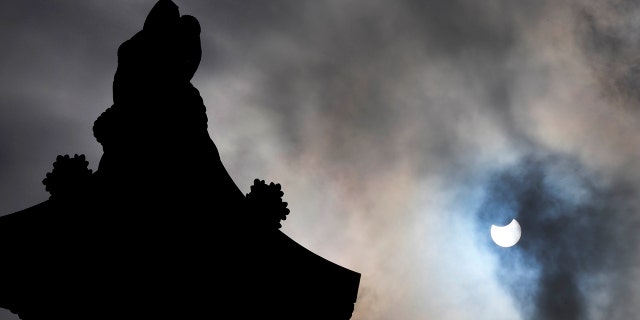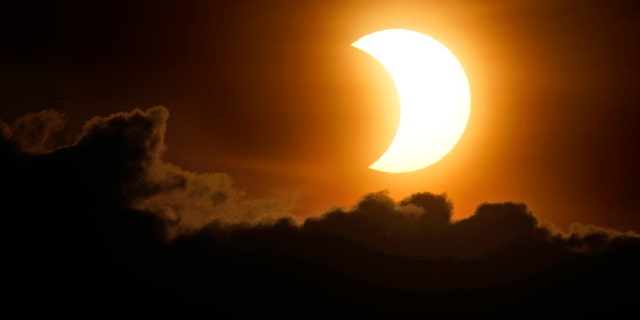NASA plans mission to Venus amid renewed interest in space exploration
Former NASA astronaut Mike Massimo tells ‘Your World’ why space has become more ‘accessible’
The “Ring of Fire” solar eclipse stunned skywatchers around the world Thursday morning.
In a cloudy New York City, the partial eclipse peeked from behind gray, puffy clouds as residents commuted to work.
Images from social media showed the eclipse behind bridges, illuminating red dawn skies and as a backdrop to iconic landmarks.
A partial solar eclipse rises over the Baltimore skyline, Thursday, June 10, 2021, seen from Arbutus, Md. (AP Photo/Julio Cortez)
Elsewhere across the Northern Hemisphere, the annular eclipse could be seen fully as the moon passed between the Earth and the sun, partially obscuring the star from view and leaving its outer ring exposed.
While the annular “ring of fire” eclipse was visible to residents of certain parts of Canada, Greenland and northern Russia, much of the Great White North, parts of the Caribbean, Europe, Asia, northern Africa, the eastern U.S. and northern Alaska were able to see the partial eclipse.
Nelson’s Column in Trafalgar Square, London, is silhouetted by a partially eclipsed sun, Thursday June 10, 2021. (AP Photo/Frank Augstein)
It appeared as if the moon had taken a “bite” of the sun: obscuring just a portion of the hot ball of glowing gases.
U.S. viewers looked to the eastern horizon to observe the eclipse, and NASA cautioned that the use of special eclipse glasses would be necessary to avoid the threat of blindness.
A man wears special glasses to watch the partial solar eclipse in Trafalgar Square in London, Thursday, June 10, 2021. (AP Photo/Frank Augstein)
The first solar eclipse of 2021, the event was anticipated to last for around an hour and 40 minutes, according to EarthSky.
Weather or location not permitting, interested parties could watch the celestial spectacle on NASA’s live YouTube coverage or sites like the Italy-based Virtual Telescope.
The sun is partially eclipsed as it rises over lower Manhattan in New York, Thursday, June 10, 2021. (AP Photo/Seth Wenig)
The next and final solar eclipse of the year will take place on Dec. 4, with totality only visible from Antarctica and southern Africa.
The next total solar eclipse visible from the U.S. will be on Apr. 8, 2024.
Source: Read Full Article






